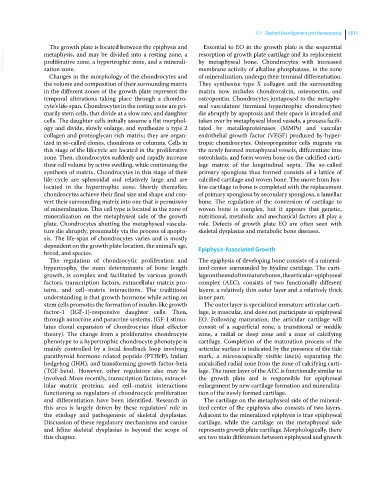Page 1573 - Clinical Small Animal Internal Medicine
P. 1573
171 Skeletal Development and Homeostasis 1511
The growth plate is located between the epiphysis and Essential to EO in the growth plate is the sequential
VetBooks.ir metaphysis, and may be divided into a resting zone, a resorption of growth plate cartilage and its replacement
by metaphyseal bone. Chondrocytes with increased
proliferative zone, a hypertrophic zone, and a minerali-
zation zone.
Changes in the morphology of the chondrocytes and membrane activity of alkaline phosphatase, in the zone
of mineralization, undergo their terminal differentiation.
the volume and composition of their surrounding matrix They synthesize type X collagen and the surrounding
in the different zones of the growth plate represent the matrix now includes chondrocalcin, osteonectin, and
temporal alterations taking place through a chondro- osteopontin. Chondrocytes juxtaposed to the metaphy-
cyte’s life‐span. Chondrocytes in the resting zone are pri- seal vasculature (terminal hypertrophic chondrocytes)
marily stem cells, that divide at a slow rate, and daughter die abruptly by apoptosis and their space is invaded and
cells. The daughter cells initially assume a flat morphol- taken over by metaphyseal blood vessels, a process facili-
ogy and divide, slowly enlarge, and synthesize a type 2 tated by metalloproteinases (MMPs) and vascular
collagen and proteoglycan rich matrix; they are organ- endothelial growth factor (VEGF) produced by hyper-
ized in so‐called clones, chondrons or columns. Cells in tropic chondrocytes. Osteoprogenitor cells migrate via
this stage of the lifecycle are located in the proliferative the newly formed metaphyseal vessels, differentiate into
zone. Then, chondrocytes suddenly and rapidly increase osteoblasts, and form woven bone on the calcified carti-
their cell volume by active swelling, while continuing the lage matrix of the longitudinal septa. The so‐called
synthesis of matrix. Chondrocytes in this stage of their primary spongiosa thus formed consists of a lattice of
life cycle are spheroidal and relatively large and are calcified cartilage and woven bone. The move from hya-
located in the hypertrophic zone. Shortly thereafter, line cartilage to bone is completed with the replacement
chondrocytes achieve their final size and shape and con- of primary spongiosa by secondary spongiosa, a lamellar
vert their surrounding matrix into one that is permissive bone. The regulation of the conversion of cartilage to
of mineralization. This cell type is located in the zone of woven bone is complex, but it appears that genetic,
mineralization on the metaphyseal side of the growth nutritional, metabolic and mechanical factors all play a
plate. Chondrocytes abutting the metaphyseal vascula- role. Defects of growth plate EO are often seen with
ture die abruptly, presumably via the process of apopto- skeletal dysplasias and metabolic bone diseases.
sis. The life‐span of chondrocytes varies and is mostly
dependent on the growth plate location, the animal’s age, Epiphysis‐Associated Growth
breed, and species.
The regulation of chondrocytic proliferation and The epiphysis of developing bone consists of a mineral-
hypertrophy, the main determinants of bone length ized center surrounded by hyaline cartilage. The carti-
growth, is complex and facilitated by various growth lage on the end of immature bones, the articular‐epiphyseal
factors, transcription factors, extracellular matrix pro- complex (AEC), consists of two functionally different
teins, and cell–matrix interactions. The traditional layers: a relatively thin outer layer and a relatively thick
understanding is that growth hormone while acting on inner part.
stem cells promotes the formation of insulin‐like growth The outer layer is specialized immature articular carti-
factor‐1 (IGF‐1)‐responsive daughter cells. Then, lage, is avascular, and does not participate in epiphyseal
through autocrine and paracrine systems, IGF‐1 stimu- EO. Following maturation, the articular cartilage will
lates clonal expansion of chondrocytes (dual effector consist of a superficial zone, a transitional or middle
theory). The change from a proliferative chondrocyte zone, a radial or deep zone and a zone of calcifying
phenotype to a hypertrophic chondrocyte phenotype is cartilage. Completion of the maturation process of the
mainly controlled by a local feedback loop involving articular surface is indicated by the presence of the tide
parathyroid hormone‐related peptide (PTHrP), Indian mark, a microscopically visible line(s) separating the
hedgehog (IHH), and transforming growth factor‐beta uncalcified radial zone from the zone of calcifying carti-
(TGF‐beta). However, other regulators also may be lage. The inner layer of the AEC is functionally similar to
involved. More recently, transcription factors, extracel- the growth plate and is responsible for epiphyseal
lular matrix proteins, and cell–matrix interactions enlargement by new cartilage formation and mineraliza-
functioning as regulators of chondrocytic proliferation tion of the newly formed cartilage.
and differentiation have been identified. Research in The cartilage on the metaphyseal side of the mineral-
this area is largely driven by these regulators’ role in ized center of the epiphysis also consists of two layers.
the etiology and pathogenesis of skeletal dysplasias. Adjacent to the mineralized epiphysis is true epiphyseal
Discussion of these regulatory mechanisms and canine cartilage, while the cartilage on the metaphyseal side
and feline skeletal dysplasias is beyond the scope of represents growth plate cartilage. Morphologically, there
this chapter. are two main differences between epiphyseal and growth

